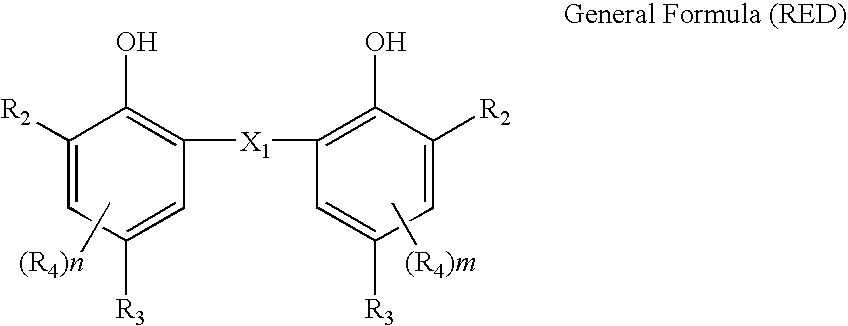Silver salt photothermographic dry imaging material
a technology of photothermographic and silver salt, applied in the field of silver salt photothermographic dry imaging material, can solve the problems of affecting the image quality of silver image tone, affecting the image quality, and exhibiting some effects, and achieves excellent storage stability, low fogging, and high speed
- Summary
- Abstract
- Description
- Claims
- Application Information
AI Technical Summary
Benefits of technology
Problems solved by technology
Method used
Image
Examples
synthetic example 1
Synthesis of P-1
[0391]Charged into a reaction vessel were 20 g of polyvinyl alcohol (Gosenol GH18) manufactured by Nihon Gosei Co., Ltd. and 180 g of pure water, and the resulting mixture was dispersed in pure water so that 10 weight percent polyvinyl alcohol dispersion was obtained. Subsequently, the resultant dispersion was heated to 95° C. and polyvinyl alcohol was dissolved. Thereafter, the resultant solution was cooled to 75° C., whereby an aqueous polyvinyl alcohol solution was prepared. Subsequently, 1.6 g of 10 percent by weight hydrochloric acid, as an acid catalyst, was added to the solution. The resultant solution was designated as Dripping Solution A. Subsequently, 11.5 g of a mixture consisting of butylaldehyde and acetaldehyde in a mol ratio of 4:5 was prepared and was designated as Dripping Solution B. Added to a 1,000 ml four-necked flask fitted with a cooling pipe and a stirring device was 100 ml of pure water which was heated to 85° C. and stirred well. Subsequentl...
example 1
>
[0518]A photographic support comprised of a 175 μm thick biaxially oriented polyethylene terephthalate film with blue tinted at an optical density of 0.170 (determined by Densitometer PDA-65, manufactured by Konica Corp.), which had been subjected to corona discharge treatment of 8 W·minute / m2 on both sides, was subjected to subbing. Namely, subbing liquid coating composition a-1 was applied onto one side of the above photographic support at 22° C. and 100 m / minute to result in a dried layer thickness of 0.2 μm and dried at 140° C., whereby a subbing layer on the image forming layer side (designated as Subbing Layer A-1) was formed. Further, subbing liquid coating composition b-1 described below was applied, as a backing layer subbing layer, onto the opposite side at 22° C. and 100 m / minute to result in a dried layer thickness of 0.12 μm and dried at 140° C. An electrically conductive subbing layer (designated as Subbing Lower Layer B-1), which exhibited an antistatic function, was...
example 2
[0592]Various types of the following silver halide emulsions were prepared employing the same method as Example 1.
(Preparation of Photosensitive Silver Halide Emulsion 6)
[0593]Photosensitive Silver Halide Emulsion 6 was prepared in the same manner as aforesaid Photosensitive-Silver Halide Emulsion 1, except that the temperature prior to the addition of Solution (G1) was set at 25° C., and after the addition of all Solution F1 after nucleolus formation, 4 ml of 0.1 percent ethanol solution of the aforesaid Compound (ETTU) was added.
[0594]The resulting emulsion was comprised of monodipsersed cubic silver iodobromide grains of an average grain size of 0.035, a variation coefficient of the particle size of 12 percent, and a [100] plane ratio of 93 percent.
(Preparation of Photosensitive Silver Halide Emulsion 7)
[0595]Photosensitive Silver Halide Emulsion 7 was prepared in the same manner as aforesaid Photosensitive Silver Halide Emulsion 1, except that the temperature prior to the additi...
PUM
| Property | Measurement | Unit |
|---|---|---|
| temperature | aaaaa | aaaaa |
| optical density | aaaaa | aaaaa |
| optical density | aaaaa | aaaaa |
Abstract
Description
Claims
Application Information
 Login to View More
Login to View More - R&D
- Intellectual Property
- Life Sciences
- Materials
- Tech Scout
- Unparalleled Data Quality
- Higher Quality Content
- 60% Fewer Hallucinations
Browse by: Latest US Patents, China's latest patents, Technical Efficacy Thesaurus, Application Domain, Technology Topic, Popular Technical Reports.
© 2025 PatSnap. All rights reserved.Legal|Privacy policy|Modern Slavery Act Transparency Statement|Sitemap|About US| Contact US: help@patsnap.com



